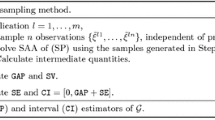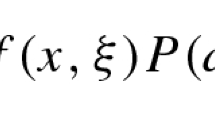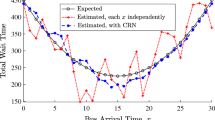Abstract
Monte Carlo sampling-based estimators of optimality gaps for stochastic programs are known to be biased. When bias is a prominent factor, estimates of optimality gaps tend to be large on average even for high-quality solutions. This diminishes our ability to recognize high-quality solutions. In this paper, we present a method for reducing the bias of the optimality gap estimators for two-stage stochastic linear programs with recourse via a probability metrics approach, motivated by stability results in stochastic programming. We apply this method to the Averaged Two-Replication Procedure (A2RP) by partitioning the observations in an effort to reduce bias, which can be done in polynomial time in sample size. We call the resulting procedure the Averaged Two-Replication Procedure with Bias Reduction (A2RP-B). We provide conditions under which A2RP-B produces strongly consistent point estimators and an asymptotically valid confidence interval. We illustrate the effectiveness of our approach analytically on a newsvendor problem and test the small-sample behavior of A2RP-B on a number of two-stage stochastic linear programs from the literature. Our computational results indicate that the procedure effectively reduces bias. We also observe variance reduction in certain circumstances.
Similar content being viewed by others
References
Bailey T., Jensen P., Morton D.: Response surface analysis of two-stage stochastic linear programming with recourse. Nav. Res. Logist. 46, 753–778 (1999)
Bayraksan G., Morton D.: Assessing solution quality in stochastic programs. Math. Program. 108, 495–514 (2006)
Bayraksan G., Morton D.: Assessing solution quality in stochastic programs via sampling. In: Oskoorouchi, M.R. (ed.) INFORMS TutORials in Operations Research, vol. 6, pp. 102–122. INFORMS, Hanover, MD (2009)
Bayraksan G., Morton D.: A sequential sampling procedure for stochastic programming. Oper. Res. 59, 898–913 (2011)
Bertocchi M., Dupačová J., Moriggia V.: Sensitivity of bond portfolio’s behavior with respect to random movements in yield curve: a simulation study. Ann. Oper. Res. 99, 267–286 (2000)
Birge, J.: Quasi-Monte Carlo approaches to option pricing. Technical report 94-19, Department of Industrial and Operations Engineering, University of Michigan (1994)
Dantzig, G., Infanger, G.: A probabilistic lower bound for two-stage stochastic programs. Technical report SOL 95-6, Department of Operations Research, Stanford University (1995)
Drew, S., de Mello, T.H.: Quasi-Monte Carlo strategies for stochastic optimization. In: Proceedings of the 2006 Winter Simulation Conference, pp. 774–782 (2006)
Dupačová J., Gröwe-Kuska N., Römisch W.: Scenario reduction in stochastic programming: an approach using probability metrics. Math. Program. 95, 493–511 (2003)
Efron B., Tibshirani R.: An Introduction to the Bootstrap. Chapman & Hall, New York (1993)
Ferguson A., Dantzig G.: The allocation of aircraft to routes: an example of linear programming under uncertain demands. Manag. Sci. 3, 45–73 (1956)
Freimer M.B., Thomas D.J., Linderoth J.T.: The impact of sampling methods on bias and variance in stochastic linear programs. Comput. Optim. Appl. 51(1), 51–75 (2012)
Heitsch H., Römisch W.: Scenario reduction algorithms in stochastic programming. Comput. Optim. Appl. 24, 187–206 (2003)
Henrion R., Küchler C., Römisch W.: Scenario reduction in stochastic programming with respect to discrepancy distances. Comput. Optim. Appl. 43, 67–93 (2009)
Higle J.: Variance reduction and objective function evaluation in stochastic linear programs. INFORMS J. Comput. 10, 236–247 (1998)
Higle J., Sen S.: Statistical verification of optimality conditions for stochastic programs with recourse. Ann. Oper. Res. 30, 215–240 (1991)
Higle J., Sen S.: Stochastic decomposition: an algorithm for two-stage linear programs with recourse. Math. Oper. Res. 16, 650–669 (1991)
Higle J., Sen, S. (1996) Stochastic Decomposition: A Statistical Method for Large Scale Stochastic Linear Programming. Kluwer, Dordrecht
Higle J., Sen S.: Statistical approximations for stochastic linear programming problems. Ann. Oper. Res. 85, 173–192 (1999)
Homem-de-Mello T.: On rates of convergence for stochastic optimization problems under non-i.i.d. sampling. SIAM J. Optim. 19, 524–551 (2008)
Infanger G.: Monte Carlo (importance) sampling within a Benders decomposition algorithm for stochastic linear programs. Ann. Oper. Res. 39, 69–95 (1992)
Kenyon A., Morton D.: Stochastic vehicle routing with random travel times. Transp. Sci. 37, 69–82 (2003)
Koivu M.: Variance reduction in sample approximations of stochastic programs. Math. Program. 103, 463–485 (2005)
Kolmogorov V.: Blossom V: a new implementation of a minimum cost perfect matching algorithm. Math. Program. Comput. 1, 43–67 (2009)
Lan, G., Nemirovski, A., Shapiro, A.: Validation analysis of robust stochastic approximation method. Math. Program. (2011). doi:10.1007/s10107-011-0442-6
Linderoth J., Shapiro A., Wright S.: The empirical behavior of sampling methods for stochastic programming. Ann. Oper. Res. 142, 219–245 (2006)
Mak W., Morton D., Wood R.: Monte Carlo bounding techniques for determining solution quality in stochastic programs. Oper. Res. Lett. 24, 47–56 (1999)
Mehlhorn, K., Schäfer, G.: Implementation of O(nmlog n) weighted matchings in general graphs: the power of data structures. J. Exp. Algorithm. 7 (2002). doi:10.1145/944618.944622
Norkin V., Pflug G., Ruszczyński A.: A branch and bound method for stochastic global optimization. Math. Program. 83, 425–450 (1998)
Partani, A.: Adaptive jacknife estimators for stochastic programming. Ph.D. thesis, The University of Texas at Austin (2007)
Partani, A., Morton, D., Popova, I.: Jackknife estimators for reducing bias in asset allocation. In: Proceedings of the 2006 Winter Simulation Conference, pp. 783–791 (2006)
Rachev S.T.: Probability Metrics and the Stability of Stochastic Models. Wiley, New York (1991)
Rockafellar R., Wets R.B.: Variational Analysis. Springer, Berlin (1998)
Römisch W.: Stability of stochastic programming problems. In: Ruszczyński, A., Shapiro, A. (eds) Handbooks in Operations Research and Management Science, vol. 10: Stochastic Programming, pp. 483–554. Elsevier, Amsterdam (2003)
Ruszczyński A.: A regularized decomposition method for minimizing a sum of polyhedral functions. Math. Program. 35, 309–333 (1986)
Ruszczyński A., Świetanowski A.: Accelerating the regularized decomposition method for two stage stochastic linear problems. Eur. J. Oper. Res. 101, 328–342 (1997)
Santoso T., Ahmed S., Goetschalckx M., Shapiro A.: A stochastic programming approach for supply chain network design under uncertainty. Eur. J. Oper. Res. 167, 96–115 (2005)
Shao J., Tu D.: The Jackknife and Bootstrap. Springer, New York (1995)
Shapiro A.: Monte Carlo sampling methods. In: Ruszczyński, A., Shapiro, A. (eds) Handbooks in Operations Research and Management Science, vol. 10: Stochastic Programming, pp. 353–425. Elsevier, Amsterdam (2003)
Shapiro A., Homem-de-Mello T.: A simulation-based approach to two-stage stochastic programming with recourse. Math. Program. 81, 301–325 (1998)
Verweij B., Ahmed S., Kleywegt A., Nemhauser G., Shapiro A.: The sample average approximation method applied to stochastic vehicle routing problems: a computational study. Comput. Optim. Appl. 24, 289–333 (2003)
Wagner, R.: Mersenne twister random number generator. http://svn.mi.fu-berlin.de/seqan/releases/seqan_1.3/seqan/random/ext_MersenneTwister.h (2009). Last accessed June 7 2012
Wets R.: Stochastic programming: solution techniques and approximation schemes. In: Bachem, A., Grötschel, M., Korte, B. (eds) Mathematical Programming: The State of the Art (Bonn 1982), pp. 560–603. Springer, Berlin (1983)
Author information
Authors and Affiliations
Corresponding author
Electronic Supplementary Material
The Below is the Electronic Supplementary Material.
Rights and permissions
About this article
Cite this article
Stockbridge, R., Bayraksan, G. A probability metrics approach for reducing the bias of optimality gap estimators in two-stage stochastic linear programming. Math. Program. 142, 107–131 (2013). https://doi.org/10.1007/s10107-012-0563-6
Received:
Accepted:
Published:
Issue Date:
DOI: https://doi.org/10.1007/s10107-012-0563-6
Keywords
- Stochastic programming
- Monte Carlo simulation
- Stability analysis
- Bias reduction techniques
- Confidence intervals
- Probability metrics




